
Of Varying Value: Harvard’s Tuition over Time
Tuition is what the Harvard thinks its education is worth: the students have to decide whether or not they agree.
Introduction
It’s no secret that attending private post-secondary institutions like Harvard is expensive. For the 2019–2020 academic year, Harvard College’s total cost of attendance, not including optional fees, was a hefty $69,607. (Assuming an average of 12.5 hours spent in class per week, tuition averages out to $159.10 per hour of class). In this article, we present the results of our analysis of Harvard’s tuition over time.

Why Tuition Matters
(For this analysis, we consider tuition as the total cost of attendance. In a general sense, one might consider Harvard as an education inclusive of experiences outside of the classroom. Then, it makes most sense to analyze the data on what we pay for the entire experience.)
There are a number of ways we can understand what the tuition is. Primarily, we think of education as a service: students choose to go on to higher education to learn skills and acquire knowledge that will be useful in their future professional or personal lives. Then, the tuition is simply how much that education is worth to students.
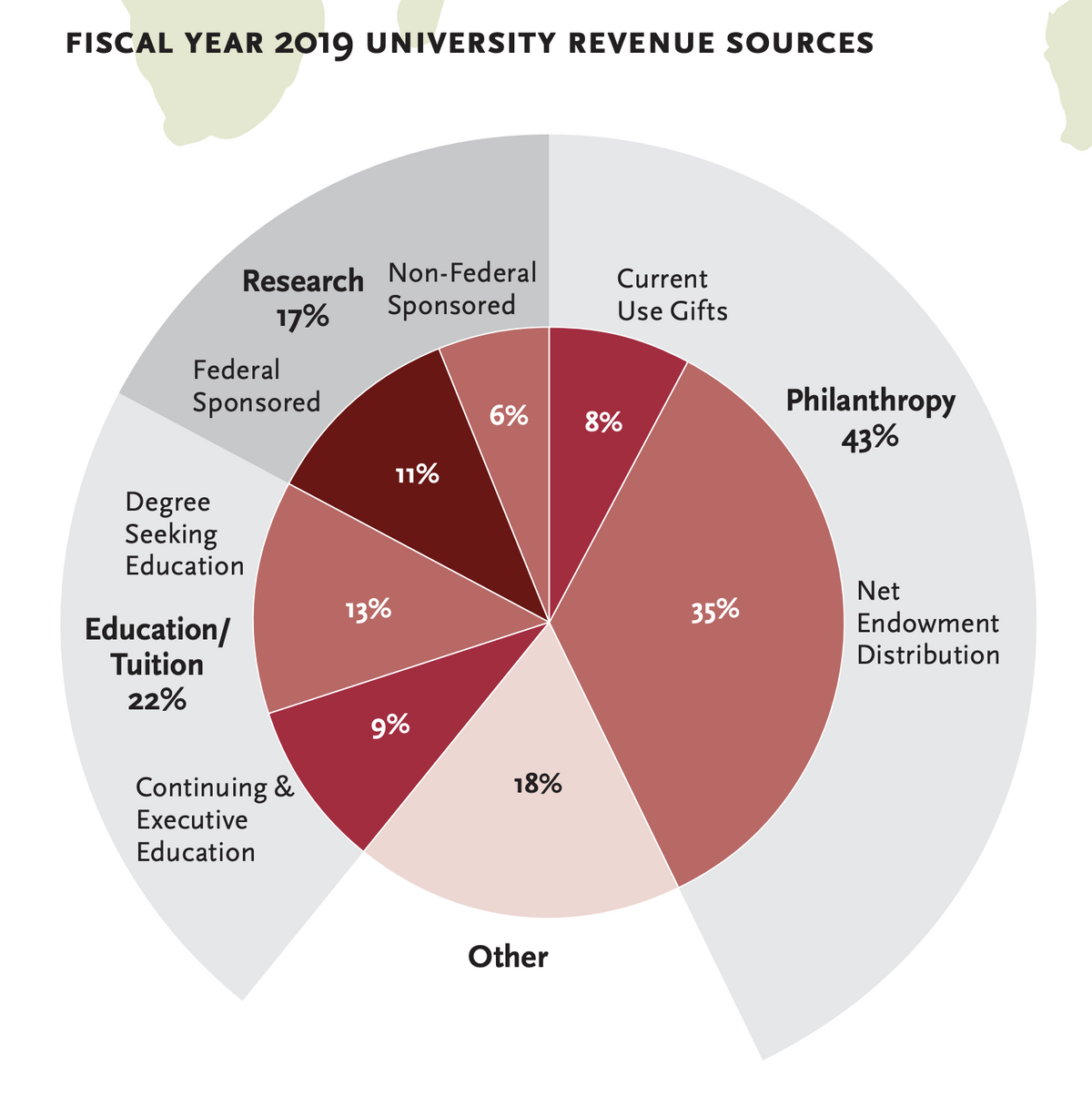 Breakdown of Harvard University’s Revenue Sources (Source: FY19 Harvard Financial Report)
Breakdown of Harvard University’s Revenue Sources (Source: FY19 Harvard Financial Report)Tuition is also a significant source of the University’s revenue.
Here, we can see that the total tuition paid by students makes up a solid 22% of Harvard University’s annual income. Changing the cost to students can significantly alter the total revenue for the University.
However, tuition can also be a significant barrier to entry. Yes, financial aid exists, and 55% of Harvard College students receive some form of need-based financial aid, but the sticker price is still what many students have to pay in some amount to attend. Due to high tuition, there are many qualified students who simply can’t afford a Harvard education, which we will discuss in more detail later.
These are two seemingly obvious results, but they beg some more interesting questions: why does tuition continue to increase every year? Why is the cost so high to begin with? Which components of the tuition increase the most, and what are the causes of these increases? Does the value of the Harvard experience actually improve at a rate commensurate with the increase in costs?
Data Collection
We analyzed Harvard College’s annual Cost of Attendance over the 35-year period from 1985 to 2020. We acquired the bulk of data (1985–2016) from the Harvard Open Data Project’s own visualization of Harvard College Tuition, Fees, Room, and Board, and supplemented the remaining years to complete our analysis from Harvard’s Office of Institutional Research’s published Common Data Sets.
Results
We divide our results in two parts: overall trends in the total cost over the time period, and trends in specific subcomponents of the total cost.
Trends in Overall Costs
First, we provide a visualization of the increase in total cost over time:

We see that not only does the tuition rise each year, but it actually rises at an increasing rate over time. The average percentage increase in total cost over the past ten years has been 3.6%.
Inflation
However, the raw increase in cost does not tell the full story, as the value of the dollar changes and fluctuates across time. Thus, using year-over-year inflation data acquired from the U.S. Bureau of Labor Statistics, we compared the percentage growth in the cost to the year-over-year inflation:
With one exception in the year 2000, the growth of the total cost has always exceeded the inflation rate. Indeed, the average difference between how much the growth in tuition has exceeded inflation over the past ten years has been 1.9%. In other words, the real cost of attendance, adjusted for inflation, has increased by an average of 1.9% over the past decade.

Even after adjusting the value of tuition to 2019 dollars, the total costs appear to be consistently rising over time. Over the last 35 years, the average real income of all but the top quintile of US households has grown relatively little.

For relatively constant incomes and increasing costs of education, the proportion of a household’s income spent on education increases. Then, it is interesting to consider: does this mean that Harvard considers the actual value of its education to be improving each year? Do Harvard students and faculty feel like the college experience improves this much year after year?
Median Income
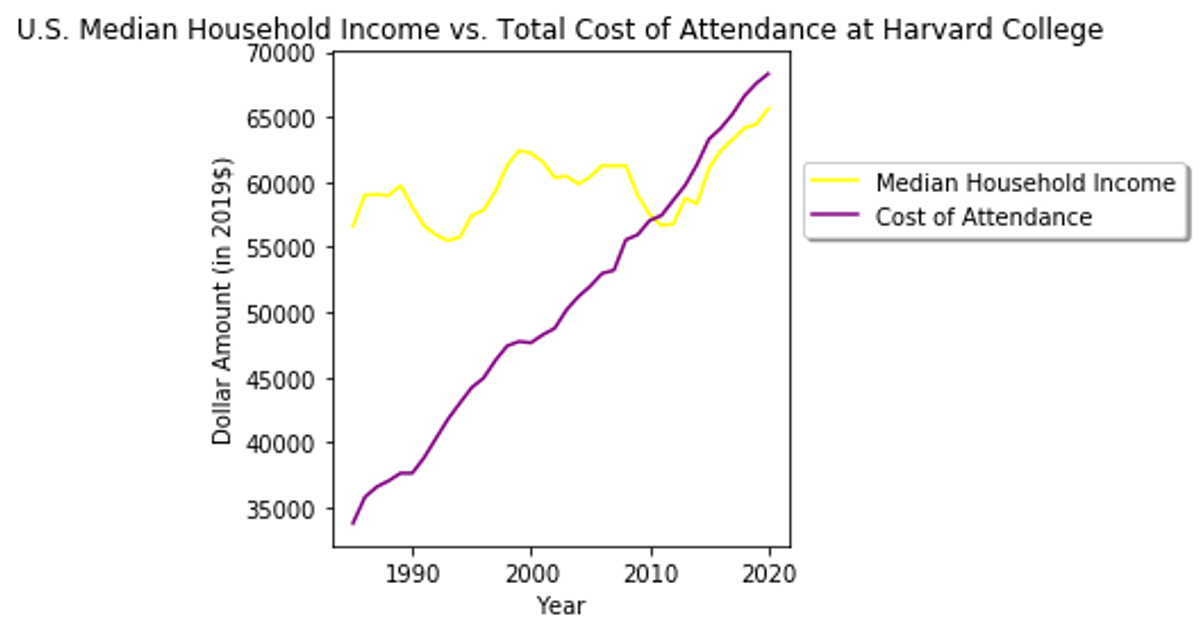
According to data collected on annual salaries, the cost of attendance only began to exceed the median income of workers in the U.S. around the year 2010. Interestingly enough, Harvard College expanded its investment in undergraduate financial aid by $10 million in 2011, providing students with $166 million in need-based scholarships. Beginning in fall 2012, financial aid was also increased for low-income students by raising the income level under which parents pay nothing towards the cost of attendance to $65,000.
Trends in Specific Costs

Here, we have plotted data on additional student fees, which include the annual student activity fee and health fee. There’s been a steady rise in the amount each student pays in additional fees, except for significant drops in 2008–09 and 2012–13; we believe these outliers may have been due to changes to the national health care policy under President Obama and his administration.
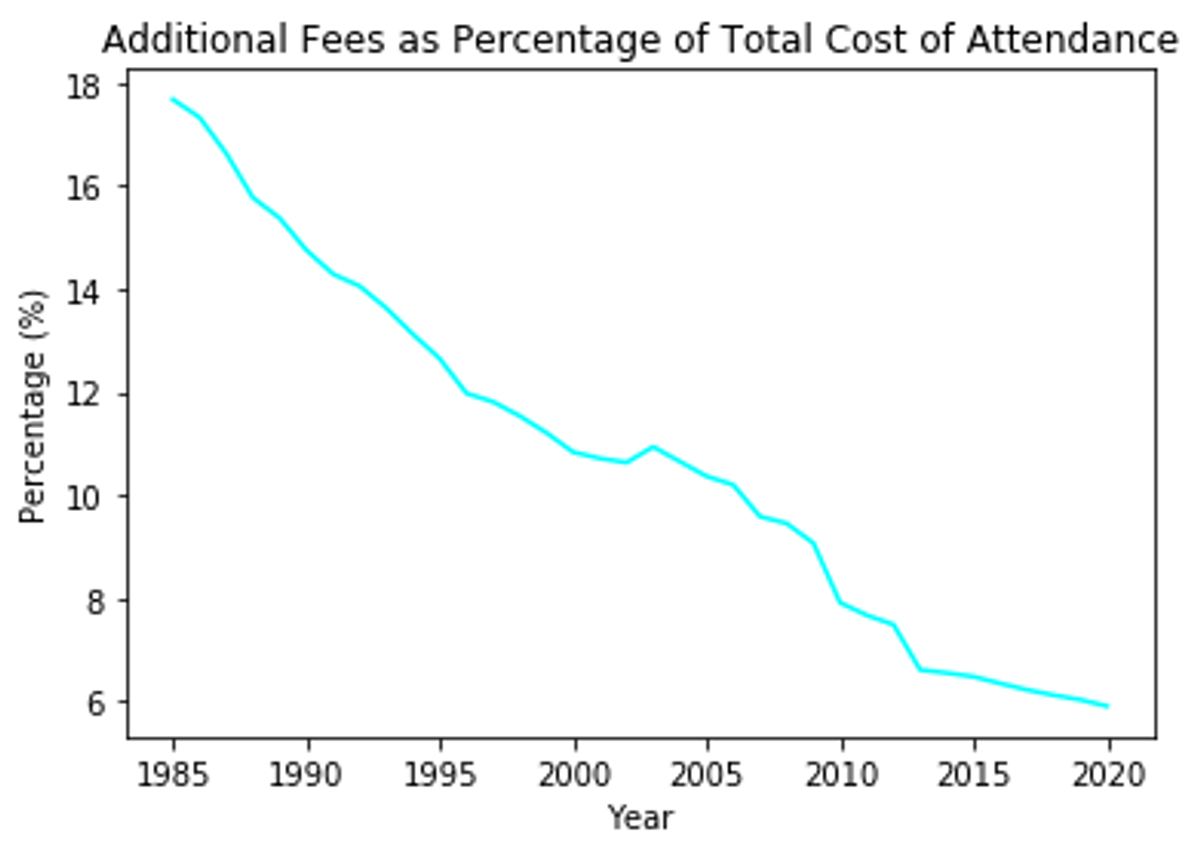
As a percentage of the total cost of attendance, however, these additional fees have continued to steadily decrease over the last 35 years. Between the years 2015 and 2019, this percentage has sat relatively close to 6%.
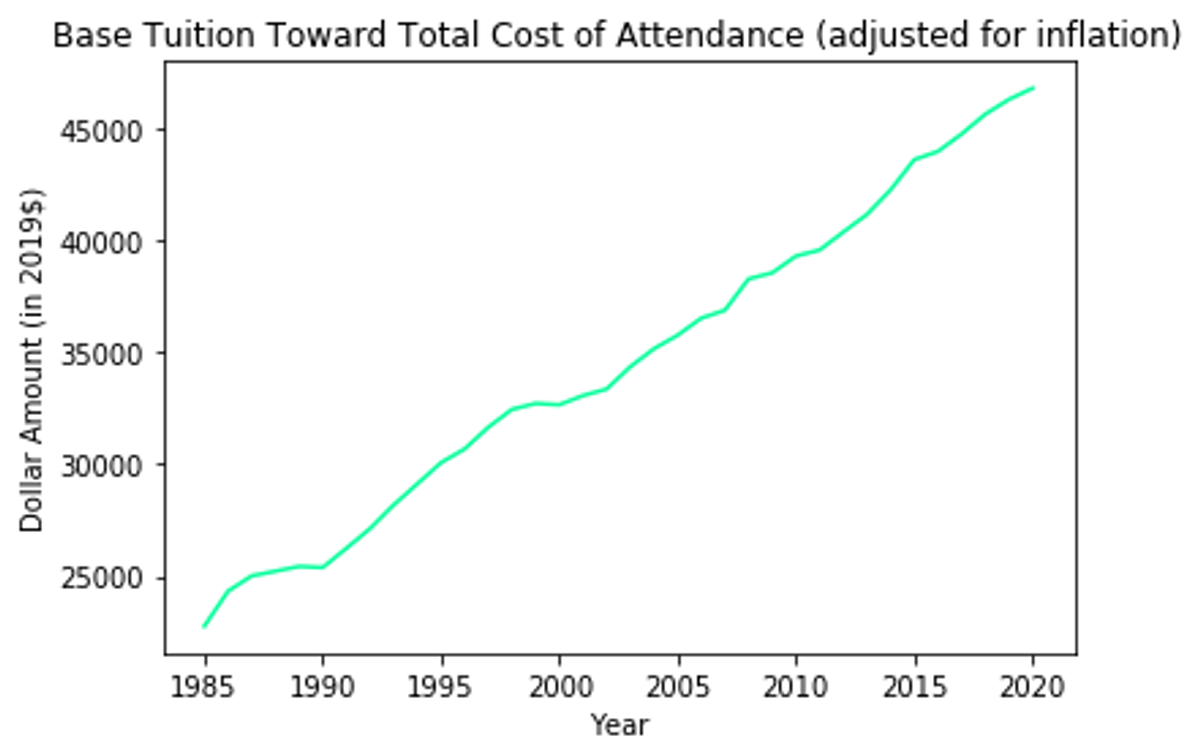
There’s also been a steady increase in base tuition since the year 1985 (not including room, board, additional fees and other personal expenses).
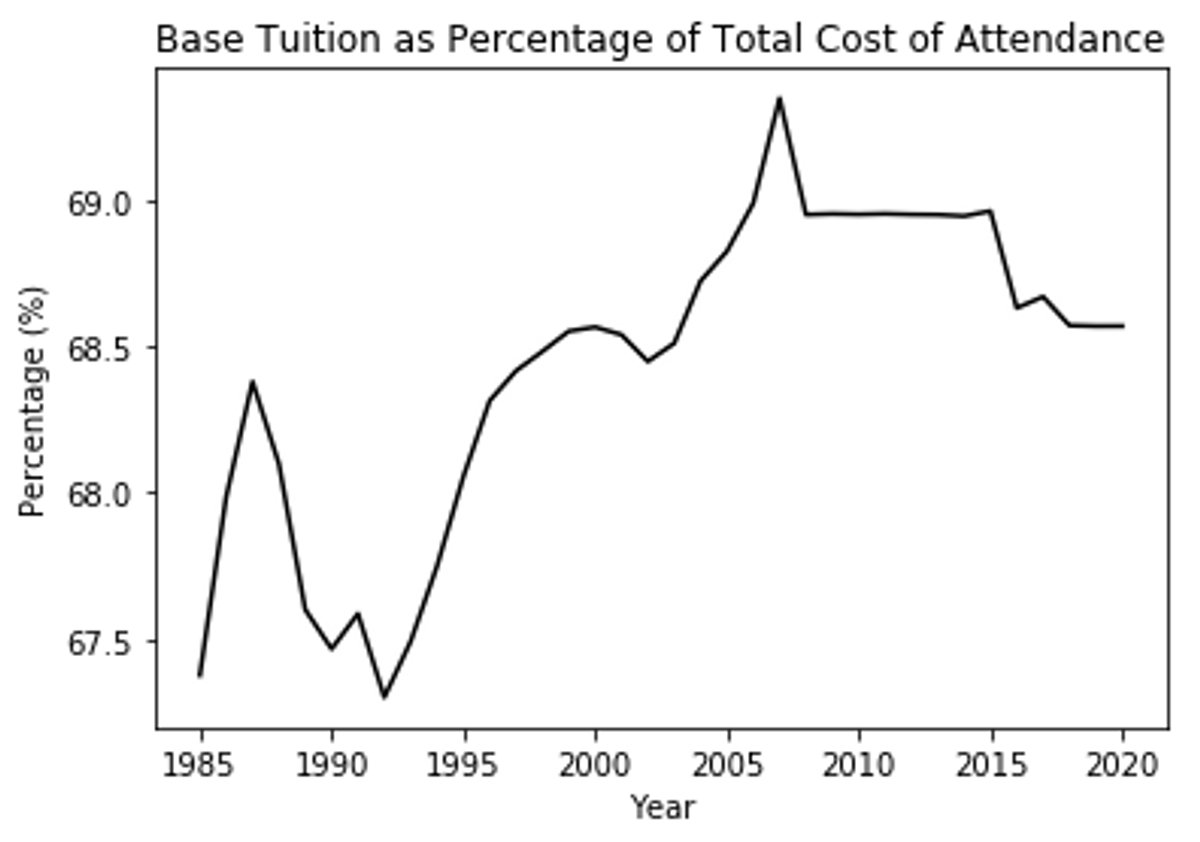
When looking at base tuition as a percentage of the total cost of attendance, we observe that it’s stayed between 65 to 70%. Though there was a noticeable increase in this percentage coming into the 21st century, it has been going back down since the year 2006 and is currently at about 68.5%.
Future Analyses
While the current analysis has generated some interesting results and points of discussion, there are still points left to be analyzed, among which we’d recommend:
- Analyze costs for other divisions of Harvard University. Harvard is not limited to the College for undergraduates, but has a total of twelve degree-granting schools. How does tuition for Harvard College compare to that of other arms of the University?
- Consider the cost of room and board in the context of the housing market. The US real estate market has seen abrupt and significant contractions and expansions in recent history, and it could be interesting to see what the data says about Harvard’s price of room and board compared to fluctuations in the larger market.
- Compare Harvard’s tuition over time to admissions data. There may be interesting trends in the relation between Harvard College’s rising costs and dropping admission rates over time.
- Compare the costs of Harvard College with peer institutions, such as the other schools in the Ivy League as well as post-secondary institutions in the Boston/New England area. It may be interesting to note differing changes in tuition over time, and this analysis would be useful if combined with a concurrent investigation of how much financial aid is being awarded to students at these other schools.
Conclusion
Harvard College is expensive, even after we’ve adjusted for annual inflation rates, and especially compared to the median U.S. household income. Of course, Harvard’s tuition is also responsive to local and domestic events, from policy decisions at the University level to larger societal currents happening on a global scale. Finally, since the College’s real costs are consistently increasing over time relative to the economy, Harvard should carefully consider the growing difference between its tuition increases and the incomes of most American families.
